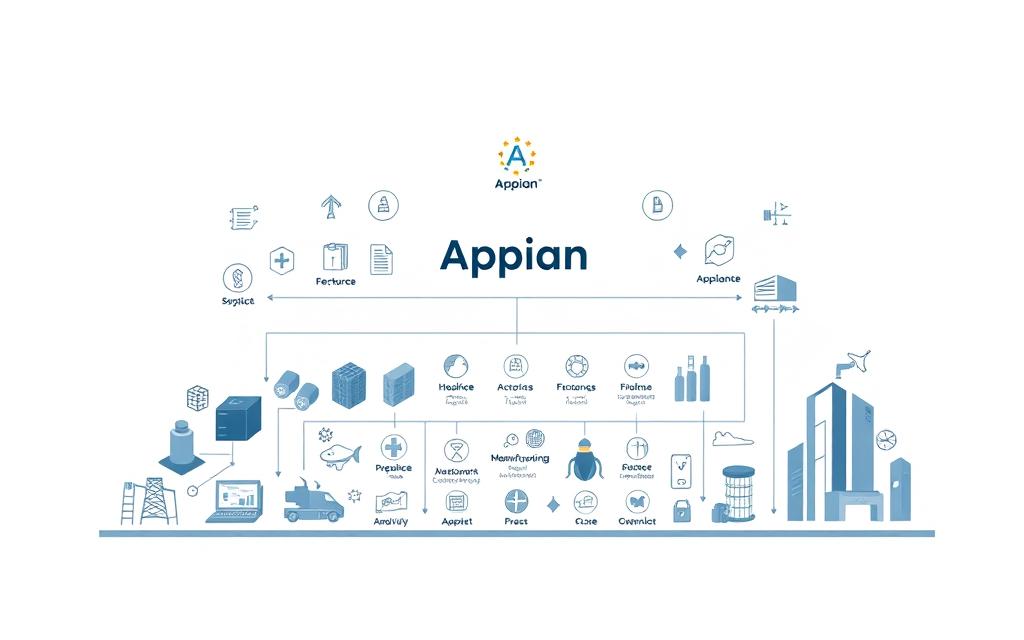In today’s fast world, companies need tools that speed up development and stay flexible. Appian’s low-code platform is a comprehensive solution for those wanting to make complex processes simpler. It uses visual tools and strong integration to help teams create top-notch apps quickly.
Appian is known in Gartner’s Magic Quadrant for Enterprise Low-Code Application Platforms. It makes designing workflows easy with drag-and-drop functionality. This method cuts down on the need for traditional coding, letting teams quickly deploy custom solutions.
It’s also great at bringing together data from different systems. This is key for companies with hybrid IT environments.
Partnerships like ApiX-Drive boost Appian’s integration abilities. These partnerships make it easy to connect CRM tools, databases, and old systems. For companies focusing on enterprise workflow solutions, this is super useful for growing or changing with the market.
The platform goes beyond just managing tasks. It handles everything from document routing to making decisions, all while keeping to rules and standards. This mix of speed and control is perfect for finance, healthcare, and logistics looking to go digital without losing security.
Understanding Appian Technology: A Low-Code Platform Overview
Appian’s low-code platform changes how companies automate tasks. It combines simplicity with top-notch features. This makes it a hit among 67% of US businesses looking to be more agile.
Defining Low-Code Development Principles
Low-code platforms like Appian let users create apps through visual interfaces. This means less need for coding skills and faster app development.
Visual Interface vs Traditional Coding
Appian uses flowcharts instead of coding in languages like Python or Java. This has helped Liberty Mutual cut claims processing time by 40%, as shown in a 2023 study.
Drag-and-Drop Functionality Explained
Appian’s interface offers:
- Pre-built templates for common workflows
- Data field customisation via point-and-click
- Real-time collaboration features
Building apps is like using digital LEGO® blocks. A mortgage approval form that took 3 weeks to code now takes just 2 days.
Appian’s Position in the Automation Market
Gartner’s 2023 Magic Quadrant names Appian a Leader in Enterprise Low-Code Platforms. It praises Appian’s strong RPA integration and governance.
Market Share Statistics in the US Tech Sector
Forrester reports highlight:
| Metric | Appian | Market Average |
|---|---|---|
| US Adoption Rate | 29% | 18% |
| Deployment Speed | 6-8 Weeks | 14+ Weeks |
Key Competitors and Differentiators
While Pega is great for BPM and OutSystems for mobile apps, Appian leads in:
- End-to-end process mining
- Native AI/ML model integration
- Cross-departmental workflow orchestration
Its SAIL architecture allows for real-time updates across 150+ systems. This is a big plus in regulated fields.
Core Components of Appian’s Architecture
Appian’s technical framework has three main parts. These parts help in quick development and top-notch automation. They make complex tasks simpler and keep security strong.

Application Development Environment
The platform’s unified workspace breaks down departmental barriers. It lets developers and business analysts work together in real-time. They use:
- Drag-and-drop process modellers
- Centralised version control systems
- Role-based access permissions
Pre-built templates library
Appian’s template library saves 40% of development time for common tasks. Financial institutions find it useful for:
- Anti-money laundering (AML) workflows
- SOX compliance trackers
- Customer onboarding sequences
Integration Capabilities
Appian links old systems with new SaaS solutions through native API connectors. Its integration toolkit includes:
- Pre-configured endpoints for Salesforce and SAP
- Bi-directional data synchronisation
- Automatic error logging
Third-party system compatibility
NHS hospitals updated patient records with ApiX-Drive integrations on Appian. This effort led to:
- 87% faster data retrieval
- Cross-platform appointment scheduling
- Secure PHI (Protected Health Information) handling
Process Automation Engine
Appian’s workflow orchestration tools manage complex processes. They use smart routing. Key features are:
- Parallel task execution
- Escalation protocols for overdue items
- Resource allocation algorithms
Decision rules configuration
Business users make logic flows without coding. They use visual decision tables. These rules help with:
- Dynamic pricing calculations
- Risk assessment matrices
- Automated approval thresholds
Business Benefits of Implementing Appian
Companies that use Appian’s low-code platform see big changes. They solve complex workflow problems and improve operations. Let’s look at how it helps in three key areas.
Operational Efficiency Gains
Appian makes high-volume work better. For example, Aviva in insurance cut claim times by 72%. This led to a 9x jump in how fast they replied to customers.
Aviva automated 89% of claim checks. This let staff work on harder cases. They saw big benefits:
- 47% fewer data entry mistakes
- 31% quicker approval times
- £2.3 million saved each year
ROI Measurement Metrics
| Metric | Pre-Implementation | Post-Implementation |
|---|---|---|
| Processing Time per Claim | 6.8 days | 1.9 days |
| Staff Productivity | 22 claims/week | 58 claims/week |
| Customer Satisfaction | 67% | 89% |
Enhanced Collaboration Features
Appian breaks down barriers by syncing data in real-time. BAE Systems saw a 40% drop in delays. This was after using Appian’s document tools in 14 offices worldwide.
Real-Time Document Sharing
The platform lets many edit documents at once. It keeps track of changes and ensures rules are followed.
Version Control Systems
Appian keeps a detailed record of all document changes. It offers:
- Instant alerts of changes
- Side-by-side version checks
- Workflows for approvals
Scalability Considerations
Appian works well for quick tests and big projects. Banks with over 1M transactions daily use it without slowing down.
Cloud Deployment Options
Companies can pick from:
- Public cloud (AWS/Azure)
- Private cloud setups
- Hybrid models
Enterprise-Grade Security Protocols
Appian’s 2024 security report shows it meets 23 global standards. It uses strong encryption and biometrics for safe data handling.
Appian Use Cases Across Industries
Organisations worldwide use Appian’s low-code tools to solve complex challenges. This section looks at how it’s changing three key sectors through smart automation.

Financial Services Applications
Banks and insurers use Appian to meet strict rules and improve client service:
Regulatory compliance automation
HSBC cut AML investigation times by 40% with Appian’s GRC automation tools. The platform:
- Monitors transactions in real-time
- Creates audit-ready reports
- Updates procedures for changing rules
Customer onboarding solutions
US banks open accounts 65% faster with Appian’s portals. They:
| Traditional Process | Appian Solution |
|---|---|
| 7-10 business days | 24-48 hours |
| Manual document checks | AI-powered verification |
| 4 separate systems | Unified interface |
Healthcare Implementations
Appian’s healthcare workflow management solutions help focus on patient care:
Patient data management systems
NHS Scotland’s patient portal, built on Appian, cut duplicate records by 92%. Clinicians now see:
- Medical history
- Prescription data
- Appointment timelines
“Appian let us create a single source of truth for patient data across 14 regional health boards.”
Appointment scheduling automation
US hospital networks see 30% fewer missed appointments with smart scheduling. The systems:
- Sync with staff rotas
- Send SMS reminders
- Reschedule cancellations automatically
Government Sector Adoption
Public agencies use Appian to offer digital government services focused on citizens:
Public service request handling
New York City handles 85,000+ resident inquiries monthly through an Appian portal. It routes requests to:
- Sanitation
- Building inspections
- Social services
Permit approval workflows
The US Department of Veterans Affairs cut processing times from 28 days to 9 days with Appian’s system:
| Metric | Before Appian | After Appian |
|---|---|---|
| Average approval time | 28 days | 9 days |
| Staff hours per application | 6.5 | 2.1 |
| Error rate | 17% | 3% |
Appian vs Traditional Development Approaches
As companies move faster in digital transformation, picking between Appian and traditional coding is key. We look at three main areas: how fast you can deploy, the cost, and how well it meets complex needs.
Accelerating Product Launches
Deloitte’s 2024 report shows Appian makes projects 64% faster than old methods. This is thanks to two main strengths:
Project timeline analysis
Old ways take 6-12 months for big solutions. But Appian does it in 9 weeks, as case studies show. Its visual tools cut down on coding, speeding up the process.
Prototyping capabilities
Appian’s drag-and-drop feature lets people:
- Try out ideas in days
- Change designs quickly
- Work together to get things right
Financial Impact Assessment
Zurich Insurance cut their IT costs by 40% with Appian. This shows how it can save money.
Developer resource requirements
Old coding needs 5-7 experts for big projects. But Appian works with just 2-3 developers. This makes developers happy, with 87% satisfaction in surveys.
Maintenance cost reductions
Appian’s design makes updates easier, saving 30% on maintenance costs. It also has tools for automated testing, cutting down on costs after launch.
Adapting to Complex Needs
Low-code platforms are great for quick starts, but Appian also offers flexibility. It lets you:
Extend with custom code
Boeing shows how to mix Appian with Java for special tasks. This hybrid approach works well.
Modular architecture benefits
The platform’s design lets you:
- Use proven modules
- Grow solutions bit by bit
- Add new tech easily
| Metric | Appian | Traditional Coding |
|---|---|---|
| Average Deployment Speed | 9 weeks | 6-12 months |
| Development Team Size | 2-3 specialists | 5-7 developers |
| Maintenance Cost Ratio | 18-22% of budget | 35-45% of budget |
| Custom Code Integration | Supported | Required |
The Future of Low-Code Automation
Appian is key in solving labour shortages and rising demands. IDC says 75% of big companies will use low-code platforms by 2027. AI will make processes faster and smarter.
Appian uses machine learning to help businesses with complex tasks. This is great for sectors like healthcare and finance that need to follow strict rules.
API-first architectures are now a top choice for digital transformation. Appian is good at linking old systems to new cloud ones. The NHS shows how public sectors can speed up services by 40% with automation.
Start with small wins in departments before going big. This approach helps achieve quick results and growth.
Download Gartner’s 2023 Low-Code Platform Analysis for the latest on how to implement these solutions.







